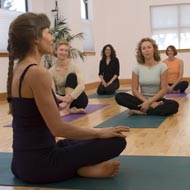- Aromatherapy (36)
- Benefits of Yoga (282)
- Home Remedies (1087)
- massage therapy (9)
- Preventive Therapy (135)
- Running (41)
- Skin Care (15)
- Stress Relief (25)
- Stretching (5)
- walking (33)
- Womens Health (14)
- Yoga Benefits for Pregnant Women (16)
- Yoga Benefits for Students (3)
- Yoga for Children (11)
- Yoga for Holistic Living (37)
- Yoga for Midlife Crisis (3)
- Yoga for Senior Citizens (2)
- Yoga for the Workplace (1)
- Yoga Health Tips (185)
- Yoga Practice during Menstruation (5)
Relationship Between Yoga And Meditation

Yoga and meditation are totally and completely interrelated. Yoga is an ancient traditional way of life encompassing thought and practice aimed at good health and wellbeing – physical, mental and emotional – that is said to culminate in moksha or nirvana (liberation or emancipation). Meditation is an intricate part of Yoga, inasmuch as it is one of the eight limbs. The eight limbs of Yoga are as follows:
- Yamas (Don’ts or Restraints)
- Niyamas (Do’s or Observances)
- Asanas (Exercises and poses)
- Pranayamas (Breathing exercises and techniques)
- Pratyahara (Control of the senses)
- Dharana (Concentration)
- Dhyana (Meditation) and
- Samadhi (A super-conscious state)
Meditation, thus, forms the seventh limb of Yoga – also variously called Raja Yoga, Ashtanga Yoga, Classical Yoga or Yoga of the Eight Limbs. It is a holistic science and art of living that aims to achieve optimum physical, mental and emotional equilibrium and, finally, unite the individual self with the Supreme Self. This, we now perceive as separate and dissimilar from us. For this reason, Yoga first and foremost concerns itself with correcting our distorted view of life.
Dhyana (Meditation) is a very powerful tool which, together with Pranayamas (breathing exercises and techniques) help cool, calm and pacify the racy mind and thus help it see things as they are. At any Yoga meditation center people are taught certain meditation techniques by which they are able to calm and quieten themselves down. The immediate results are manifest in a healthy body and a tranquil mind. While a lot of Yoga meditation centers only restrict themselves to meditative practices, most do not. Meditation techniques are taught in conjunction with certain other practices, including the all important Asanas (exercises and poses) and Pranayamas (breathing exercises and techniques).
The Role Of Yoga Centers In Meditation
It is difficult to plunge right into meditation and achieve any great results. Although there are hundreds of institutions, worldwide, that teach solely meditative practices of some sort or another, strictly speaking, Yoga students are advised to desist, at least in the beginning. It is only after one has familiarized oneself with the basics and fundamentals of Yoga that one is encouraged to learn meditation. Different schools of meditation teach different meditative techniques. Thus you have Vipassana Meditation – one of the most prevalent and popular in the world today – breath meditation, sound meditation, color meditation, odor meditation, chakra meditation and many others that latter day Yogis have come up with. They all carry different benefits and are designed to suit different types and personalities, depending upon one’s age, experience and spiritual evolvement.
- RSS Feeds -
- All posts
- All comments
- Insight Into Breathing Most of us are rarely aware of what breath is. But the moment something ob...
- Broad Overview On Pranayama Pranayama, the Yoga breathing technique is a very important part of the scien...
- Buddhist Meditation Meditation means training the mind, and it is present in some form or the oth...
- What is special about Buddhist meditation? Meditation means training the mind, and it is present in some form or the oth...